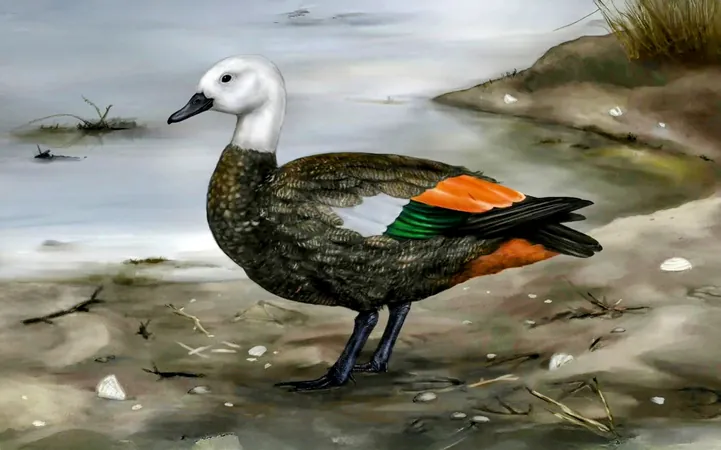
How an Extinct Duck from the Chatham Islands Sheds Light on Island Evolution
2025-08-18
Author: Li
On the isolated Rēkohu Chatham Islands, an ancestral duck, which had flown there hundreds of thousands of years ago, evolved into a sturdier and more ground-oriented bird. With its wings shortening and legs lengthening, this now-extinct species showcases the remarkable ways island life can influence animal evolution.
Recent research spearheaded by the University of Otago has unveiled a new species of shelduck, named Tadorna rekohu, also known as the Rēkohu shelduck. This name was granted by the Hokotehi Moriori Trust, the custodians of Rēkohu’s natural history.
Adaptations to Island Life
The Rēkohu shelduck underwent significant evolutionary changes over time, leaning toward flightlessness. Co-lead author Nic Rawlence highlighted that the duck's evolution involved shorter, sturdier wings and longer legs, which provided evidence that these adaptations were sensible given the island’s plentiful food and lack of ground predators.
Co-lead author Pascale Lubbe explained that flying requires a lot of energy, so in an environment where food is abundant, the need to fly diminishes. As a result, the longer leg bones likely allowed for stronger muscles, necessary for any launching effort.
Piecing Together the Past
Scientists unraveled the shelduck’s history using ancient DNA and bone analysis. By sequencing mitochondrial DNA from Chatham Islands fossils and comparing it with existing species, they unveiled its deep-rooted connections to the pūtangitangi paradise shelduck found on mainland New Zealand.
The analysis showed that the Rēkohu shelduck is a sister species to T. variegata, reflecting significant evolutionary divergences shaped by the unique island environment.
The Impact of Isolation
Located about 785 kilometers (488 miles) east of New Zealand, the Chatham Islands have long been a hotspot for unique bird species. Before human arrival, at least eight varieties of waterfowl thrived on the islands, all adapting to the specific challenges of island life.
This phenomenon is well-documented; birds on islands often display reduced flight capabilities, stronger legs, and spend more time on the ground. The Rēkohu shelduck exemplifies this trend with a longer, thinner head and relatively stubbier wings, adapting to roaming and foraging.
The Final Chapter: Overhunting
The Rēkohu shelduck's extinction occurred before the 19th century, likely due to overhunting by the Moriori people, exacerbated by habitat destruction and introduced predatory species. This tragic end aligns with numerous other island species that have similarly vanished after evolving in isolation.
A Story of Rapid Evolution
Documenting Tadorna rekohu does more than enrich the historical narrative; it highlights how swiftly island ecosystems can influence the anatomy and behavior of species. The findings reinforce the notion that the Chatham Islands once supported a more diverse community of waterfowl than exists today.
As researchers continue to investigate the islands’ fossils and genetics, new discoveries will likely emerge. They serve as vital reminders of how landscapes shape species, and how fragile these species are without protective stewardship.
The study is published in the Zoological Journal of the Linnean Society, emphasizing the collaboration between local communities and scientists in preserving the legacies of these remarkable birds.

 Brasil (PT)
Brasil (PT)
 Canada (EN)
Canada (EN)
 Chile (ES)
Chile (ES)
 Česko (CS)
Česko (CS)
 대한민국 (KO)
대한민국 (KO)
 España (ES)
España (ES)
 France (FR)
France (FR)
 Hong Kong (EN)
Hong Kong (EN)
 Italia (IT)
Italia (IT)
 日本 (JA)
日本 (JA)
 Magyarország (HU)
Magyarország (HU)
 Norge (NO)
Norge (NO)
 Polska (PL)
Polska (PL)
 Schweiz (DE)
Schweiz (DE)
 Singapore (EN)
Singapore (EN)
 Sverige (SV)
Sverige (SV)
 Suomi (FI)
Suomi (FI)
 Türkiye (TR)
Türkiye (TR)
 الإمارات العربية المتحدة (AR)
الإمارات العربية المتحدة (AR)